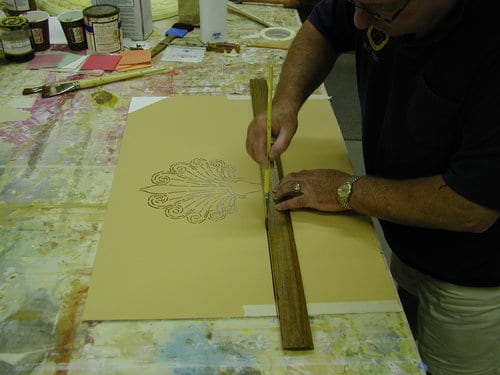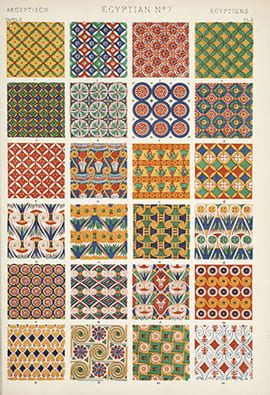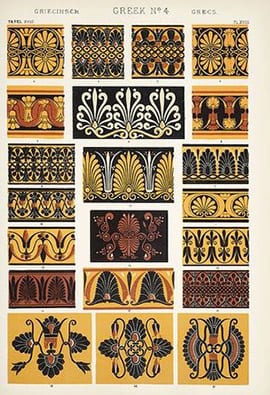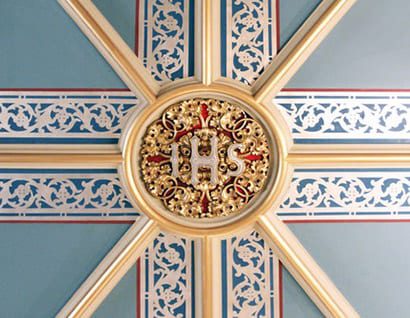Stencil Design: The Simple Technique for Complex Designs
stincilla → stencellen → stencil
Latin → Middle English → Modern English
The word “stencil” has itself been traced and evolved over the years—from the Latin scintilla (spark) to the Middle English stansele (decorate with bright colors)—to get to our current usage of the term. From the Latin ornere meaning to adorn, ornamentation of stencil design adorns the objects or architecture.
WHAT WE MEAN WHEN WE SAY “STENCIL”
Though stenciling is a relatively simple technique, it can achieve the most mesmerizing and complex designs. The intended pattern of the stencil begins as a sketch. That sketch is finessed and discussed by those involved in a project to make sure the proper symbolism and design is being illustrated. The drawing is then made into a vector in illustrator, printed on plastic, and cut. Once the stencil has been cut, it is used to apply a painted or finished design. Stencils can be used to apply a design to a range of materials and canvases, and for a range of purposes. Typically, when we talk about stenciling, we are referring to the process as it applies to architectural projects.



Now, this process may seem very simple at first, but the intricacies of a repetitive design are not “do it yourself.”
As always, the design process is the most time consuming; skill and artistic understanding are required to compose a detail that will have a consistent repetitive motion. The artist must understand the location of where the stencil will be placed, whether on the exterior or the interior of a building, so the design is large or small enough in order for the imagery to be properly appreciated.




A SHORT HISTORY OF STENCILING & EXAMPLES
In the early 1800s , painting troupes would travel from city to city, town to town searching for work in the decorative arts.The painting companies were not unlike The John Canning Co. in the sense that they offered decorative painting, stenciling, wood graining, and various other services. As cities developed, these traveling studios set up shops in central locations in order to be more available to the hustle and bustle of construction and repair. We are not much unlike our decorative painting ancestors; even though today you can go to school to learn the techniques of the decorative arts the most efficient way to learn these methods is through apprenticeship. Being in the studio with so many incredible artists is a wealth of knowledge in and of itself. The word “stencil” may have come into modern vocabulary in the 1800s but the technique has been around since the 5th century. Almost all cultures use or have used a method of stencil design on objects, artwork or architecture.Ancient Egyptian Stencil Designs
For example, the ancient Egyptian used stencils to decorate the walls of tombs, to ornament artwork, and at times, for hieroglyphics. The early Egyptians were superior in art only to themselves in the sense that they were not influenced by other cultures until later in their history. The palaces of the Egyptians have long been lost to merciless time, however we can imagine designs similar to those illustrated here would have adorned palaces and government buildings. Artwork can be found in the Metropolitan Museum of Art in New York City.



Ancient Greek Stencil Designs
The Greeks were close observers of nature. They would abstract and make perfect that which surrounded them following the basic rules of the outside world. All objects grow out of a parent stem, proportionate distribution of objects, and the tangential curvature of the lines are carefully observed. Ancient Greek stencil design can be best studied today from vases like the one pictured here. Amphora can be found in the British Museum in London.



Islamic Stencil Design
Islamic stenciling and ornamentation closely aligns itself with Owen Jones’s principle regarding beauty in architecture and how, if done correctly, it can result in a “repose which the mind feels when the eye, the intellect, and the affections are satisfied, from the absence of any want.” The ornamentation carefully and naturally arises from the surface decorated, the ornamentation is in seamless harmony with the object or architecture. The Dome of the Selimiye Mosque in Edirne, Turkey is a phenomenal example of such work in action.



STENCILING & OUR WORK
Below are some examples of projects we have worked on in the past which required incredible attention to detail and stenciling techniques.Doris Duke’s Shangri La, Hawaii




Rodeph Shalom Synagogue, Pennsylvania




Basilica of St. John the Evangelist, Stamford, CT




Citations
Jones, Owen. The Grammar of Ornament. London: Messrs Day and Son, 1856.